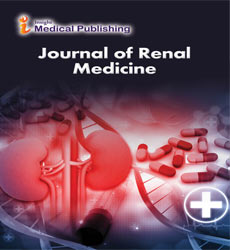The Role of VA-ECMO and the Efficacy of Different Renal Replacement Therapies
Huang Li*
Department of Nephrology, The First Affiliated Hospital of Kunming Medical University, Kunming, China
- *Corresponding Author:
- Huang Li
Department of Nephrology, The First Affiliated Hospital of Kunming Medical University, Kunming,
China,
E-mail: lihuang@china.com
Received date: June 21, 2024, Manuscript No. IPJRM-24-19520; Editor assigned date: June 24, 2024, PreQC No. IPJRM-24-19520 (PQ); Reviewed date: July 08, 2 024, QC No. IPJRM-24-19520; Revised date: July 15, 2024, Manuscript No. IPJRM-24-19520 (R); Published date: July 22, 2024, DOI:10.36648/ipjrm.7.4.38
Citation: Li H (2024) The Role of VA-ECMO and the Efficacy of Different Renal Replacement Therapies. J Ren Med Vol.7 No.4: 38.
Description
Venoarterial Extracorporeal Membrane Oxygenation (VAECMO) fills in as a fundamental lifesaving mediation, offering a help to patients wrestling with extreme respiratory disappointment, stubborn cardiogenic shock, or joined cardio respiratory disappointment. While the reception of ECMO has flooded, it has brought along a range of complexities, including Acute Kidney Injury (AKI), disease, hemolysis, apoplexy and dying. Among these, AKI arises as a predominant confusion, with its rate going generally from 26%-85%, to a great extent credited to varieties in quiet socioeconomics and the measures utilized for conclusion across studies. Extreme AKI requiring Renal Replacement Therapy (RRT) emerges in roughly 45% of cases, with liquid overburden positioning as the dominating sign. Strikingly, AKI requiring RRT worries about a critical concern of high death rates and negative clinical results.
Modalities of renal replacement therapy
Different modalities of Renal Replacement Therapy (RRT) are vital parts in overseeing AKI in patients going through VA-ECMO, included Intermittent Hemodialysis (IHD), Prolonged Intermittent Renal Replacement Therapy (PIRRT), Continuous Renal Replacement Therapy (CRRT) and Peritoneal Dialysis (PD). Nonetheless, among these choices, CRRT and PD arise as champion decisions because of their ability to keep up with hemodynamic security and slowly address metabolic uneven characters, delivering them especially reasonable for ECMO-upheld patients contrasted with elective modes. While CRRT brags the benefit better tuned liquid and electrolyte the executives, its usage is blocked by raised expenses and restricted availability, especially in asset restricted settings. PD, on the other hand, uses the peritoneal membrane for solute diffusion and ultrafiltration, making it a simpler and possibly less expensive method. Regardless of its perceived convenience, security and viability in liquid evacuation, especially in neonatal populaces, there is an absence of significant information on the utilization of PD in grown-up ECMO patients. Also, concerns continue in regards to the hypothetical expanded hazard of peritonitis, catheter-related entanglements and possible impedance with diaphragmatic developments related with PD.
Acute Kidney Injury (AKI)
A common medical problem for critically ill hospitalized patients is Acute Kidney Injury (AKI). AKI is likewise a typical difficulty of serious consume injury. The recurrence of AKI related with serious consumes and consume related sepsis has been accounted for as high as 30% and conveys with it huge mortality going from 30%-80%. Given the recurrence of AKI in seriously consumed patients, critical study has been led to recognize risk factors for the advancement of AKI in this quiet populace to help with early acknowledgment and mediation to work on understanding results. Much of the time refered to gamble with factors for the improvement of consume related AKI are more established age, bigger percent absolute body surface region, profundity of consume, inhalational injury, raised confirmation serum creatinine and Blood Urea Nitrogen (BUN), shock, sepsis, mechanical ventilation and rhabdomyolysis. Presently, Continuous Renal Replacement Therapy (CRRT) is the methodology of decision to treat serious AKI in fundamentally sick ICU patients, both general ICU and consume related patients. CRRT is in many cases liked over discontinuous hemodialysis as a result of precise volume control, consistent corrosive base and electrolyte remedy and upkeep of hemodynamic steadiness. The timing of when to begin CRRT in critically ill patients-whether as an early or delayed intervention is currently the subject of debate in the literature. As a rule, clinical markers with regards to when to start CRRT follow the related/KDIGO rules, including corrosive base unsettling influences, rhabdomyolysis, volume over-burden, hyperkalemia and poisons. Utilization of CRRT is related with further developed endurance and quicker return of renal capability in consume related AKI patients in the ICU. Despite the widespread use of CRRT in burn-related AKI, little research has examined the long-term renal function outcomes in this patient population. Subsequently, the point of this study was to play out a review partner diagram survey to portray copy patients who created AKI with CRRT during their confirmation at Vancouver General Hospital (VGH) and check out at the drawn out results of renal capability for these patients. The speculation of this study was that consume patients who encourage AKI getting renal help by means of CRRT during their visit in clinic have return of typical, or near ordinary renal capability long haul.
Open Access Journals
- Aquaculture & Veterinary Science
- Chemistry & Chemical Sciences
- Clinical Sciences
- Engineering
- General Science
- Genetics & Molecular Biology
- Health Care & Nursing
- Immunology & Microbiology
- Materials Science
- Mathematics & Physics
- Medical Sciences
- Neurology & Psychiatry
- Oncology & Cancer Science
- Pharmaceutical Sciences
